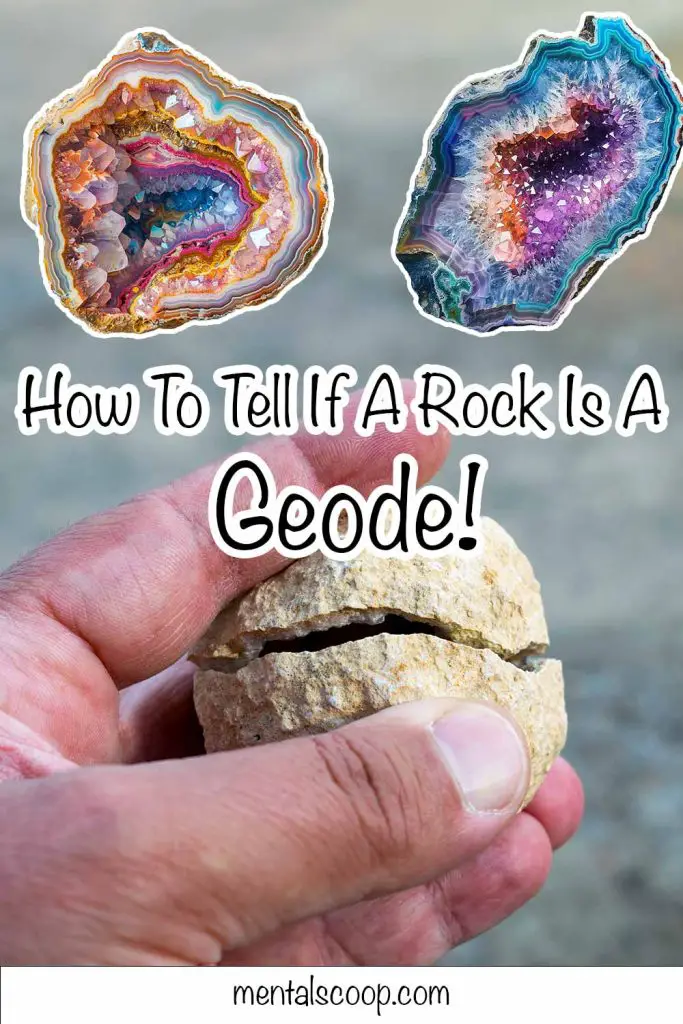How To Tell If A Rock Is A Geode!

Geodes are nature’s hidden treasures, plain on the outside but often sparkling with crystals on the inside. Discovering a geode can be an exciting experience, whether you’re a geology enthusiast or just someone with a keen interest in nature.
This guide will help you identify if that ordinary-looking rock in your hand might be hiding a stunning crystal formation. Here’s how to tell if a rock is a geode, broken down into nine detailed steps.
Understanding What a Geode Is
Before identifying a geode, it’s essential to understand what they are. Geodes are hollow, spherical rocks lined with crystals or other mineral matter.
Formed in volcanic or sedimentary environments, they often have a rough, nondescript exterior, which makes them easy to overlook. The magic happens inside, where minerals have crystallized over millions of years, creating beautiful, sparkling interiors.
Location, Location, Location: Finding Geode Hotspots
Geodes are commonly found in specific regions around the world. In the United States, popular geode hunting spots include areas in Iowa, Missouri, Utah, and California.
Worldwide, geodes are often found in deserts, volcanic ash beds, or regions with limestone deposits. If you’re in one of these areas, your chances of finding a geode are significantly higher.
Shape and Size: Identifying Potential Geodes
Geodes typically have a round or oval shape, which is a good starting point when identifying them. They can range in size from tiny to as large as several feet in diameter.
When you’re out in the field, look for rocks that are more or less spherical. However, remember that not all spherical rocks are geodes, and not all geodes are perfectly round.
Weight Test: Lightness Can Be a Clue
One distinguishing feature of geodes is that they are often lighter than solid rocks of the same size. This is due to their hollow nature. Pick up the rock and judge its weight. If it feels lighter than you would expect for a rock of its size, it might be a geode. This test is not foolproof, but it’s a good initial check.
Surface Texture: Look for a Bumpy Exterior
The exterior of a geode is usually rough and bumpy, not smooth. This bumpy texture is due to the rock’s formation process, where mineral deposits settled and crystallized over time. When inspecting rocks, run your fingers over the surface. A rough, uneven texture can be a good indicator that you’re holding a geode.
Sound Test: The Hollow Echo
Another intriguing way to identify a potential geode is the sound test. Lightly tap the rock with another rock or a hammer. If it is a geode, you may hear a hollow sound, indicating the cavity inside. This method requires a bit of practice and a good ear, but it can be a helpful tool in your geode-hunting toolkit.
Cracking It Open: Revealing the Inner Beauty
The most definitive way to determine if a rock is a geode is to crack it open. This should be done carefully to preserve the crystal formations inside.
Tools like a chisel and hammer, or even a geode cracker, are ideal for this task. Remember to wear safety goggles and gloves. If you find a hollow interior lined with crystals, congratulations—you’ve found a geode!
Mineral Identification: Knowing Your Crystals
Once you’ve cracked open your geode, identifying the minerals inside can be both exciting and educational. Common crystals found in geodes include quartz, amethyst, and calcite.
Each mineral has unique characteristics in terms of color, shape, and hardness. A good field guide or a visit to a geology museum can help you identify the crystals inside your geode.
Preserving and Displaying Your Geode
After successfully identifying and opening a geode, you might want to preserve and display it. Geodes make stunning natural decorations. Clean the crystals gently with water and a soft brush to remove any debris. Avoid harsh chemicals that might damage the crystals.
Once cleaned, find a place where light can shine through or onto the crystals, enhancing their natural sparkle.
Finding and identifying geodes can be a thrilling adventure. With a bit of knowledge and patience, you can uncover these hidden gems and enjoy their natural beauty. Always respect nature and collect responsibly. Happy geode hunting!
Geodes are a testament to nature’s ability to create beauty in unexpected places. Whether you’re a novice rockhound or an experienced geologist, the thrill of discovering a geode never fades.
By following these steps, you can increase your chances of finding and identifying these fascinating natural formations. Happy hunting!

More interesting articles you may be interested in reading:

